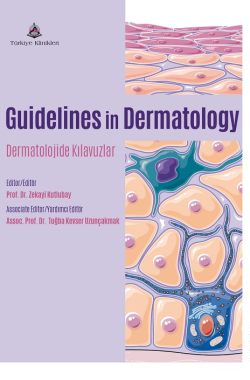BASAL CELL CARCINOMA
Güllü Gencebay1
Özlem Su Küçük2
1Bezmialem University, Faculty of Medicine, Department of Dermatology and Venereology, İstanbul, Türkiye
2Bezmialem University, Faculty of Medicine, Department of Dermatology and Venereology, İstanbul, Türkiye
Gencebay G, Su Küçük Ö. Basal Cell Carcinoma. In: Kutlubay Z, editor. Guidelines in Dermatology. 1st ed. Ankara: Türkiye Klinikleri; 2025. p.285-291.
ABSTRACT
Basal cell carcinoma (BCC) is the most prevalent non-melanoma skin cancer (NMSC) globally, with increasing incidence rates and healthcare costs, particularly in Europe and the U.S. Despite its high frequency, BCC rarely metastasizes or causes mortality. Its pathogenesis is largely associated with mutations in the Hedgehog (Hh) signaling pathway and the p53 suppressor gene. UV radiation, genetic predisposition, and factors like ionizing radiation, arsenic exposure, and immunosuppression (e.g., HIV infection or organ transplantation) significantly increase BCC risk. Certain genetic syndromes such as xeroderma pigmentosum, basal cell nevus syndrome, Bazex–Dupré–Christol syndrome, and Rombo syndrome can lead to early-onset BCC. Clinically, BCC is categorized into four major subtypes: nodular, superficial, morpheaform, and fibroepithelial (fibroepithelioma of Pinkus). Nodular BCC is the most common, presenting as pearly papules or nodules, often on the face. Dermoscopic features include arborizing vessels and blue-gray structures. Superficial BCC appears as erythematous, scaly macules or plaques, often on the trunk. Morpheaform BCC is more aggressive, presenting as scarlike plaques. Fibroepithelial BCC typically occurs on the lower back as a soft, skin-colored plaque. Non-invasive diagnostics, such as dermoscopy and reflectance confocal microscopy (RCM), enhance diagnostic accuracy. Dermoscopy offers 98.6% sensitivity and a diagnostic probability of 99%, identifying vascular, pigment-related, and non-pigmented structures. RCM improves specificity but is limited by cost and training requirements. Treatment primarily involves surgical excision, effective in over 95% of cases. Mohs micrographic surgery is reserved for high-risk, recurrent, or anatomically critical tumors. Recommended margins are 2-5 mm for low-risk BCC and 5-15 mm for high-risk cases. For tumors larger than 2 cm, margins of at least 13 mm may be necessary. Non-surgical treatments include radiotherapy, photodynamic therapy, topical agents (imiquimod, 5-fluorouracil), and targeted therapies like Hedgehog inhibitors (vismodegib, sonidegib). Cemiplimab, an immunotherapy, is approved for advanced BCC resistant to other treatments.Follow-up varies, with annual monitoring recommended for high-risk patients or those with multiple tumors.
Keywords: Non-melanoma skin cancer; Basal cell carcinoma; Pathogenesis; Staging; Treatment
Kaynak Göster
Referanslar
- Verkouteren JAC, Ramdas KHR, Wakkee M, Nijsten T. Epidemiology of basal cell carcinoma: scholarly review. Br J Dermatol. 2017 Aug;177(2):359-372.Epub 2017 Feb 20. [Crossref] [PubMed]
- Hernandez LE, Mohsin N, Levin N, Dreyfuss I, Frech F, Nouri K. Basal cell carcinoma: An updated review of pathogenesis and treatment options. Dermatol Ther. 2022 Jun;35(6):e1550. Epub 2022 Apr 12. [Crossref] [PubMed] [PMC]
- Heath MS, Bar A. Basal Cell Carcinoma. Dermatol Clin. 2023 Jan;41(1):13-21. [Crossref] [PubMed]
- Kim DP, Kus KJB, Ruiz E. Basal Cell Carcinoma Review. Hematol Oncol Clin North Am. 2019 Feb;33(1):13-24. [Crossref] [PubMed]
- Soyer HP, Rigel DS and McMeniman E. Actinic Keratosis, Basal Cell Carcinoma, and Squamous Cell Carcinoma. In: Bolognia JL, Schaffer JV, Cerroni L, eds. Dermatology. 4th ed. US; 2018. p.1872-1893.
- Cameron MC, Lee E, Hibler BP and et. al. Basal cell carcinoma: Epidemiology; pathophysiology; clinical and histological subtypes; and disease associations. J Am Acad Dermatol. 2019 Feb;80(2):303-317. [Link]
- Wozniak-Rito A, Zalaudek I, Rudnicka L. Dermoscopy of basal cell carcinoma. Clin Exp Dermatol. 2018 Apr;43(3):241-247. [Crossref] [PubMed]
- Campanella G, Navarrete-Dechent C, Liopyris K and et al. Deep Learning for Basal Cell Carcinoma Detection for Reflectance Confocal Microscopy. J Invest Dermatol. 2022 Jan;142(1):97-103. [Crossref] [PubMed] [PMC]
- Shahriari N, Grant-Kels JM, Rabinovitz H, Oliviero M, Scope A. Reflectance confocal microscopy: Diagnostic criteria of common benign and malignant neoplasms, dermoscopic and histopathologic correlates of key confocal criteria, and diagnostic algorithms. J Am Acad Dermatol. 2021 Jan;84(1):17-31. [Crossref] [PubMed]
- Stanoszek LM, Wang GY, Harms PW. Histologic Mimics of Basal Cell Carcinoma. Arch Pathol Lab Med. 2017 Nov;141(11):1490-1502. [Crossref] [PubMed]
- Ad Hoc Task Force; Connolly SM, Baker DR, Coldiron BM, and et al. AAD/ACMS/ASDSA/ASMS 2012 appropriate use criteria for Mohs micrographic surgery: a report of the American Academy of Dermatology, American College of Mohs Surgery, American Society for Dermatologic Surgery Association, and the American Society for Mohs Surgery. J Am Acad Dermatol. 2012 Oct;67(4):531-50. [PubMed]
- Basset-Seguin N, Herms F. Update in the Management of Basal Cell Carcinoma. Acta Derm Venereol. 2020 Jun 3;100(11):adv00140. [Crossref] [PubMed] [PMC]
- Kunstfeld R, Nguyen VA. New therapeutic developments for basal cell carcinoma. J Dtsch Dermatol Ges. 2023 Apr;21(4):382-385. [Crossref] [PubMed]

